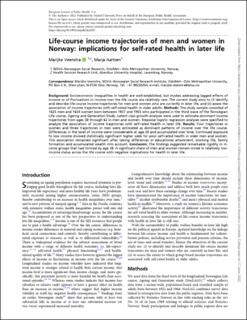Life-course income trajectories of men and women in Norway: Implications for self-rated health in later life
Peer reviewed, Journal article
Published version
Date
2022Metadata
Show full item recordCollections
Abstract
Socioeconomic inequalities in health are well-established, but studies addressing lagged effects of income or of fluctuations in income over the life course are relatively rare. The current study aims to (i) identify and describe life-course income trajectories for men and women who are currently in later life; and (ii) assess the association of income trajectories with self-rated health in older adults. Methods: The study sample consisted of 1625 men and 1634 women born between 1937 and 1955 who participated in the third wave of the Norwegian Life course, Ageing and Generation Study. Latent class growth analyses were used to estimate dominant income trajectories from ages 30 through 62 in men and women. Stepwise logistic regression analyses were specified to analyze the association of income trajectories with self-rated health in later life. Results: Four trajectories in women and three trajectories in men were estimated as dominant patterns of income over the life course. Differences in the level of income were considerable at age 30 and accumulated over time. Continued exposure to low income showed statistically significant higher odds for poor self-rated health in older men and women. This association remained significant after taking differences in educational attainment, working life, family formation and accumulated wealth into account. Conclusion: The findings suggested remarkable rigidity in income groups that had formed by age 30. A significant share of men and women remain mired in relatively lowincome status across the life course with negative implications for health in later life.

